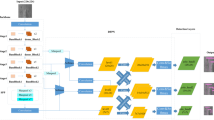Abstract
In this paper, an efficient similarity measure method is proposed for printed circuit board (PCB) surface defect detection. The advantage of the presented approach is that the measurement of similarity between the scene image and the reference image of PCB surface is taken without computing image features such as eigenvalues and eigenvectors. In the proposed approach, a symmetric matrix is calculated using the companion matrices of two compared images. Further, the rank of a symmetric matrix is used as similarity measure metric for defect detection. The numerical value of rank is zero for the defectless images and distinctly large for defective images. It is reliable and well tolerated to local variations and misalignment. The various experiments are carried out on the different PCB images. Moreover, the presented approach is tested in the presence of varying illumination and noise effect. Experimental results have shown the effectiveness of the proposed approach for detecting and locating the local defects in a complicated component-mounted PCB images.







Similar content being viewed by others
References
Bai X, Fang Y, Lin W, Wang L, Ju BF (2014) Saliency-based defect detection in industrial images by using phase spectrum. IEEE Trans Ind Inform 10:2135–2145
Jian C, Gao J, Ao Y (2017) Automatic surface defect detection for mobile phone screen glass based on machine vision. Appl Soft Comput 52:348–358
Cheng H, Liu Z, Hou L, Yang J (2016) Sparsity-induced similarity measure and its applications. IEEE Trans Circuits Syst Video Technol 26:613–626
Dong Y, Du B, Zhang L, Zhang L (2017) dimensionality reduction and classification of hyperspectral images using ensemble discriminative local metric learning. IEEE Trans Geosci Remote Sens 55:2509–2524
Gaidhane VH, Hote YV, Singh V (2016) Emotion recognition using eigenvalues and Levenberg–Marquardt algorithm-based classifier. Sadhana 41:415–423
Gaidhane VH, Hote YV, Singh V (2014) An efficient approach for face recognition based on common eigenvalues. Pattern Recognit 47:1869–1879
Costa CE, Petrou M (2000) Automatic registration of ceramic tiles for the purpose of fault detection. Mach Vis Appl 11:225–230
Son S, So H, Kim J, Choi D, Lee HJ (2015) Energy-efficient adaptive optical character recognition for wearable devices. Electron Lett 52:113–115
Sun TH, Liu CS, Tien FC (2008) Invariant 2D object recognition using eigenvalues of covariance matrices, re-sampling and autocorrelation. Expert Syst Appl 35:1966–1977
Wei SD, Lai SH (2008) Fast template matching based on normalized cross correlation with adaptive multilevel winner update. IEEE Trans Image Process 17:2227–2235
Zhang Z, Deriche R, Faugeras O, Luong QT (1995) A robust technique for matching two uncalibrated images through the recovery of the unknown epipolar geometry. Artif Intell 78:87–119
Tsai DM, Yang RH (2005) An eigenvalue-based similarity measure and its application in defect detection. Image Vis Comput 23:1094–1101
Li M, Yuan B (2005) 2D-LDA: a statistical linear discriminant analysis for image matrix. Pattern Recognit Lett 26:527–532
Debella-Gilo M, Kaab A (2011) Sub-pixel precision image matching for measuring surface displacements on mass movements using normalized cross-correlation. Remote Sens Environ 115:130–142
Weinberger KQ, Saul LK (2009) Distance metric learning for large margin nearest neighbor classification. J Mach Learn Res 10:207–244
Ying Y, Huang K, Campbell C (2009) Sparse metric learning via smooth optimization. In: Advances in neural information processing systems, pp 2214–2222
Xu C, Tao D, Xu C, Rui Y (2014) Large-margin weakly supervised dimensionality reduction. In: Proceedings of the 31st international conference on machine learning (ICML-14), pp 865–873
Ercal F, Allen M, Feng H (2000) A systolic difference algorithm for RLE-compressed images. IEEE Trans Parallel Distrib Syst 11:433–443
Ibrahim Z,. Al-Attas SAR, Aspar Z (2002) Analysis of the wavelet-based image difference algorithm for PCB inspection. In: Proceedings of the 41st SICE annual conference, pp 2108–2113
Moganti M, Ercal F, Dagli CH, Tsunekawa S (2011) Automatic PCB inspection algorithms: a survey. Comput Vis Image Underst 63:287–313
Kumar A (2008) Computer-vision-based fabric defect detection: a survey. IEEE Trans Ind Electron 55:348–363
Tsai DT, Lin CT (2003) Fast normalized cross correlation for defect detection. Pattern Recognit Lett 24:2625–2631
Tsai DM, Lin CT, Chen JF (2003) The evaluation of normalized cross correlations for defect detection. Pattern Recognit Lett 24:2525–2535
Tsai DM, Chiyang IY, Tsai YH (2012) A shift-tolerant dissimilarity measure for surface defect detection. IEEE Trans Ind Inf 8:128–137
Chen X, Liu N, Bo Y, Bo Xiao (2016) A novel method for surface defect inspection of optic cable with short-wave infrared illuminance. Infrared Phys Technol 77:456–463
Datta K (1982) An algorithm to determine if two matrices have common eigenvalues. IEEE Trans Autom Control 27:1131–1133
Gaidhane VH, Hote YV, Singh V (2015) Image focus measure based on polynomial coefficients and spectral radius. Signal Image Video Process 9:203–211
Luan H, Qi F, Xue Z, Chen L, Shen D (2008) Multimodality image registration by maximization of quantitative–qualitative measure of mutual information. Pattern Recognit 41:285–298
Belbachir AN, Lera M, Fanni A, Montisci A (2005) An automatic optical inspection system for the diagnosis of printed circuits based on neural network. In: Proceedings of the IEEE industry applications, pp 680–684
Author information
Authors and Affiliations
Corresponding author
Rights and permissions
About this article
Cite this article
Gaidhane, V.H., Hote, Y.V. & Singh, V. An efficient similarity measure approach for PCB surface defect detection. Pattern Anal Applic 21, 277–289 (2018). https://doi.org/10.1007/s10044-017-0640-9
Received:
Accepted:
Published:
Issue Date:
DOI: https://doi.org/10.1007/s10044-017-0640-9




